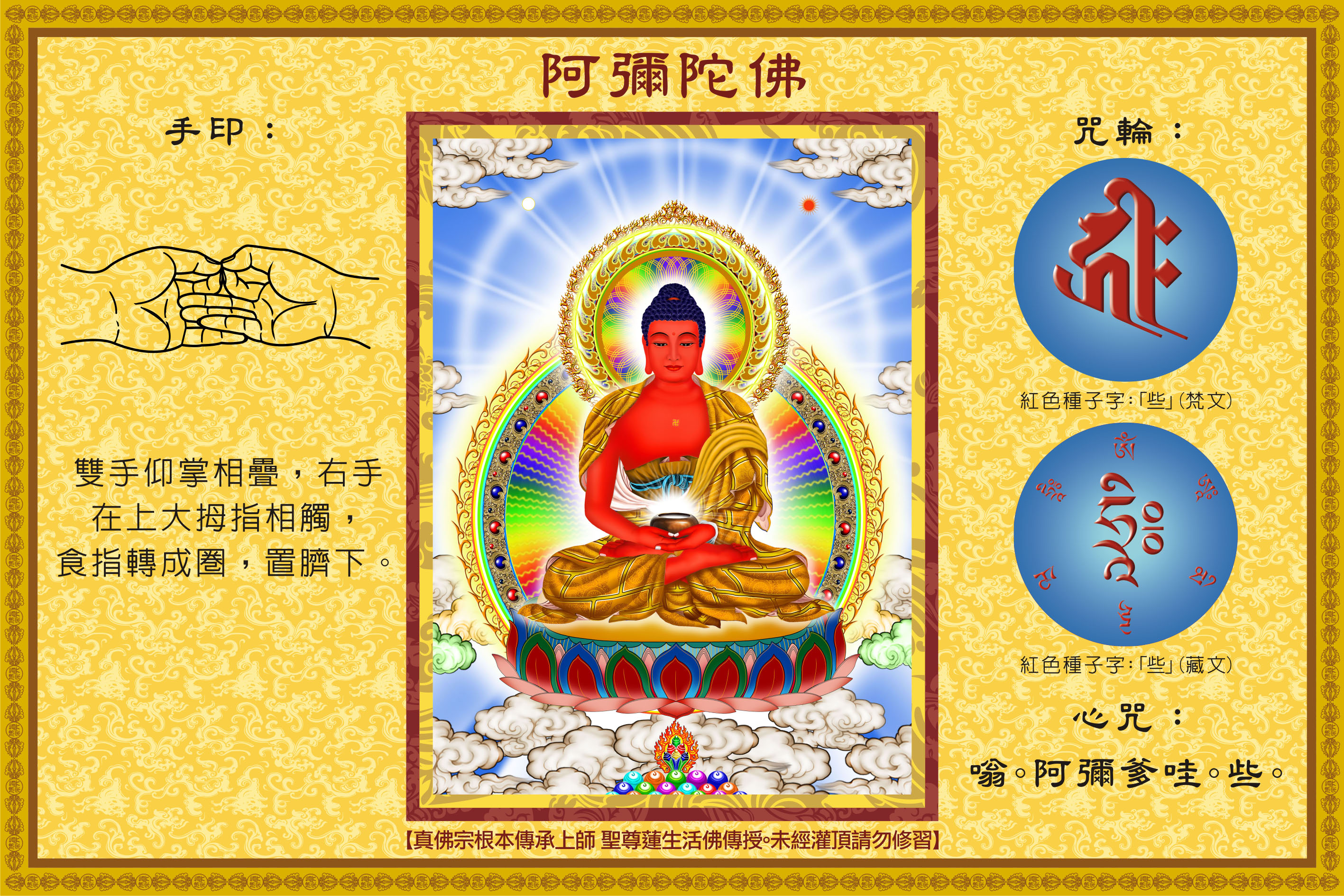首頁 (home) | 佛緣 (fate) | 隨喜 (rejoice) | 功德 (donation)
阿彌陀佛 अमिताभ Amitābha 阿弥陀如来

中文:
阿彌陀佛(梵語:अमिताभ,Amitābha),意為無量光佛,另名無量壽佛(梵語:अमितायूस्,Amitāyus),又稱為無量清淨佛、觀自在王佛、得自性清淨法性佛,在華人地區習慣作彌陀佛、彌陀等簡稱;在大乘佛教信仰中,祂是西方極樂世界的教主。
在大乘佛教初期發展時,阿彌陀佛與東方妙喜世界的阿閦佛有同樣地位,密宗以其佛為五方佛之一,為蓮花部主,主妙觀察智。在唐朝,善導大師楷定淨土宗之念佛法門,阿彌陀佛成為漢傳佛教中的信仰主流之一。
在梵語中,無量光(अमिताभ,Amitābha)與無量壽(अमितायूस्,Amitāyus)都來自同一個字根 अमिता(Amita,音譯阿彌陀)。अमिता(Amita)來自梵語動詞字根मा,mā-,源自原始印歐字根 *meh₁-,意為「測量、量度、被計算」,拉丁文同源詞metiri>mensus>mensurare>英文measure,mā的過去分詞形態 mita(彌陀);否定冠詞अ,a-,音譯「阿」,拉丁文、英文同源詞a-/an-/un-/u-;a加上mita意為「無量、無法測量、無法計算」。後綴 ābha 是「光」的意思,意譯為「無量光」,音譯阿彌陀婆或阿彌多婆。另一個梵文名 Amitāyus,後綴 āyus 是「壽命」的意思,意譯為「無量壽」,音譯阿彌陀庾斯。
最早傳入中國的與淨土有關的經典為《般舟三昧經》,由支婁迦讖於東漢時漢靈帝光和二年翻譯。該經描述了通過觀想或念誦佛名,而使十方諸佛特別是阿彌陀佛現前的法門要義。
《阿彌陀經》由鳩摩羅什翻譯。該經用簡潔華麗的筆法描繪淨土世界的清淨莊嚴,並有持名念佛的法門。現存唐玄奘的重譯,名為《稱讚淨土佛攝受經》。
與《阿彌陀經》類似的短篇佛經尚有《阿彌陀鼓音聲王陀羅尼經》,簡稱《鼓音聲經》,譯者不詳。該經也是釋迦解說阿彌陀佛功德之作,但有兩點特色:一為經中記載的阿彌陀佛父母之名;二為經內含的「鼓音聲王大陀羅尼」。
《觀無量壽經》簡稱《觀經》,乃劉宋畺良耶舍譯。此經目的在於指導淨土修行者對極樂世界進行觀想,其中十六種觀門中的最後三種主要描述了「九品往生」的狀況。唐善導大師著有《觀經四帖疏》,係鑑於當時修行人錯解念佛法門,故楷定正確之方法,其云「此義已請證定竟,一句一字不可加減,欲寫者一如經法,應知。」
《無量壽經》是淨土宗的主要經典,介紹了阿彌陀佛前世為法藏比丘的功德和他立誓成佛所許的根本願。該經有眾多譯本,現存的有東漢、孫吳、曹魏、唐朝、宋朝譯出的五種不同版本。其中唐代譯本被明代的藕益大師認為是五個譯本中最佳的,而曹魏版則得到印光大師的支持,流傳較廣。
密教的《無量壽如來念誦儀軌》、《觀自在王如來修行法》、《無量壽如來十甘露真言》等法門。而單純的密經中,阿彌陀佛也時常占有重要的位置,作為蓮花部的部祖,也是大日如來妙觀察智的顯現。因此,對阿彌陀佛的崇拜和密教手印與儀軌結合在一起。
English:
Amitābha (Sanskrit: अमिताभ, IPA: [ɐmɪˈtaːbʱɐ]), also known as Amitāyus, is the primary Buddha of Pure Land Buddhism. In Vajrayana Buddhism, he is known for his longevity, discernment, pure perception, purification of aggregates, and deep awareness of emptiness. He possesses infinite merit resulting from good deeds over countless past lives as a bodhisattva named Dharmākara.
Attainment of Buddhahood
According to the Larger Sūtra of Immeasurable Life, Amitābha was, in very ancient times and possibly in another system of worlds, a monk named Dharmākara. In some versions of the sūtra, Dharmākara is described as a former king who, having come into contact with Buddhist teachings through the buddha Lokeśvararāja, renounced his throne. He then resolved to become a Buddha and to create a buddhakṣetra (literally "buddha-field", often called a "Pureland" or "Buddha Land": a realm existing in the primordial universe outside of ordinary reality, produced by a buddha's merit) possessed of many perfections. These resolutions were expressed in his forty-eight vows, which set out the type of Pureland Dharmākara aspired to create, the conditions under which beings might be born into that world, and what kind of beings they would be when reborn there.
In the versions of the sutra widely known in China, Vietnam, Korea and Japan, Dharmākara's eighteenth vow was that any being in any universe desiring to be reborn into Amitābha's pure land (Chinese: 淨土; pinyin: jìngtǔ; Japanese pronunciation: jōdo; Korean: 정토; romaja: jeongto; Vietnamese: tịnh độ) and calling upon his name with sincerity, even as few as ten times will be guaranteed rebirth there. His nineteenth vow promises that he, together with his bodhisattvas and other blessed Buddhists, will appear before those who, at the moment of death, call upon him. This openness and acceptance of all kinds of people has made belief in pure lands one of the major influences in Mahāyāna Buddhism. Pure Land Buddhism seems to have first become popular in Gandhara, from where it spread to China and influenced by Taoists and Confucian philosophy before spreading to Central and East Asia.
The sutra goes on to explain that Amitābha, after accumulating great merit over countless lives, finally achieved buddhahood and created a pure land called Sukhāvatī (Sanskrit: "possessing happiness"). Sukhāvatī is situated in the uttermost west, beyond the bounds of our own world. By the power of his vows, Amitābha has made it possible for all who call upon him to be reborn into this land, there to undergo instruction by him in the dharma and ultimately become bodhisattvas and buddhas in their turn (the ultimate goal of Mahāyāna Buddhism). From there, these same bodhisattvas and buddhas return to our world to help yet more people while still residing in his land of Sukhāvatī, whose many virtues and joys are described.
日本語:
阿弥陀如来(あみだにょらい)は、大乗仏教の如来の一つである。浄土教系の仏教では、「南無阿弥陀仏」という称名念仏により浄土に往生できるという阿弥陀信仰を説く。西方にある極楽浄土という仏国土(浄土)の教主とされる(東方は薬師如来)。五智如来においては、西方に位置する観自在王如来と同一視するが、真言宗では阿弥陀が法蔵菩薩であったときに師事した仏として、別尊とする。
梵名はアミターバ(अमिताभ, Amitābha)、あるいはアミターユス (अमितायुस्, Amitāyus)といい、それを阿弥陀と音写する。阿弥陀仏(阿弥陀佛)ともいい、また略して弥陀仏ともいう。
梵名のアミターバは「量しれない光を持つ者」、アミターユスは「量りしれない寿命を持つ者」の意味で、これを漢訳して・無量光仏、無量寿仏ともいう。
浄土三部経
「浄土三部経」の内、『無量寿経』と『阿弥陀経』の成立時期については、無量寿経の成立時期と編纂者を参照。
『観無量寿経』については、サンスクリット原典が2011年現在発見されていない。中央アジアで作成されたと考えられる。
『仏説無量寿経』
一切の衆生救済のために王位を捨てて、世自在王仏のもとで法蔵菩薩と名乗り修行し、衆生救済のための五劫思惟し、浄土への往生の手立てを見出し、衆生救済のための「四十八願」を発願したのち、改めて誓いを立て修行し、それが成就し仏となった報身仏と説かれる。また、現在も仏国土である「極楽」で説法をしていると説かれている。
特に浄土教諸宗においては、「四十八願」のうち「第十八願」を重要視する。
『仏説阿弥陀経』
「極楽」のありさまと、阿弥陀仏の徳が説かれる。東方・南方・西方・北方・下方・上方世界のガンジス河の砂の数ほどの諸仏から賞賛されていると説かれる。そして「極楽」に生まれる方法が説かれる。
COPYRIGHT © Dukkha Buddhism | Donation since 2006